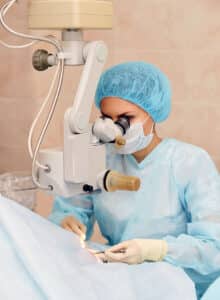Medically reviewed by Ijeoma Astoa
Corneal transplants restore clarity to a cloudy or scarred cornea by replacing damaged tissue with healthy donor grafts.
When your vision starts to blur or distort—whether from keratoconus, Fuchs’ dystrophy, or scarring—it can affect everything from driving to reading a text. Daily tasks become frustrating, and the search for answers often leads to the possibility of a corneal transplant.
While that may sound overwhelming, understanding your options is the first step toward regaining control of your sight and routine. This guide walks you through what to expect, from the types of corneal transplants available to candidacy, surgery, and recovery. Our goal at Barnet Dulaney Perkins is to help you move forward with clarity and confidence.
What Is a Corneal Transplant?

A corneal transplant—called keratoplasty—removes diseased or damaged corneal tissue and replaces it with a donor graft from an eye bank. The cornea’s transparency and smooth curvature focus light onto the retina; when it becomes opaque, vision blurs. Transplants restore this clarity by introducing healthy layers that integrate seamlessly with the eye.
Penetrating Keratoplasty (PK)
Penetrating keratoplasty, or full-thickness transplant, remains the gold standard for widespread corneal disease. During PK, surgeons remove a circular button of your entire corneal thickness and stitch in a matching donor graft. According to the National Eye Institute, PK has a high long-term success rate, though recovery may take 12–18 months as stitches dissolve and astigmatism stabilizes (NIH.gov).
Deep Anterior Lamellar Keratoplasty (DALK)
Deep anterior lamellar keratoplasty offers a tissue-preserving alternative when disease spares the innermost corneal layer (the endothelium). In DALK, surgeons remove the front layers of Descemet’s membrane, leaving the endothelium intact. This reduces rejection risk and speeds healing, though it demands advanced surgical skill.
Endothelial Keratoplasty: DSAEK vs. DMEK
For conditions like Fuchs’ dystrophy, where only the innermost cells fail, two partial-thickness techniques prevail:
-
DSAEK (Descemet’s-Stripping Automated Endothelial Keratoplasty): Replaces Descemet’s membrane and endothelium, plus a thin stroma layer. Patients enjoy clearer vision within 1–2 months and lower rejection rates than PK.
-
DMEK (Descemet’s Membrane Endothelial Keratoplasty): This procedure transplants only Descemet’s membrane and endothelium. Recovery accelerates to 1–2 weeks for initial clarity and 1–2 months for complete stabilization. DMEK provides the sharpest vision and lowest rejection risk among grafts.
Who Is a Candidate for Corneal Transplants?

-
Keratoconus unresponsive to cross-linking
-
Fuchs’ endothelial dystrophy causes chronic swelling
-
Deep corneal scarring from injury or infection
-
Failed prior grafts or corneal decompensation
A comprehensive eye exam, including corneal topography and pachymetry, guides the choice between full- and partial-thickness transplants.
What to Expect During Surgery
Corneal transplants are typically outpatient procedures:
-
Anesthesia: Local or general, based on patient comfort and complexity.
-
Tissue Removal: Precision instruments excise diseased tissue.
-
Graft Placement: Donor tissue aligns to the exact dimensions.
-
Fixation: PK uses sutures; DSAEK/DMEK relies on an internal air or gas bubble.
-
Immediate Aftercare: You rest briefly before discharge, often within hours.
Recovery and Aftercare
Healing timelines vary by procedure:
-
PK: Vision clears gradually over 12–18 months. Regular suture adjustments manage astigmatism.
-
DALK: Stability arrives in 6–12 months, with suture removal usually sooner.
-
DSAEK: Most patients notice improvement in 1–2 months; gas bubble positioning requires lying face-up briefly post-op.
-
DMEK: Initial clarity arrives within 1–2 weeks; complete stabilization in 1–2 months.
Across all techniques, you’ll use antibiotic and steroid eye drops to prevent infection and rejection. Attend scheduled exams so your surgeon can monitor graft health and intraocular pressure.
Ready to Restore Your Vision?
Corneal transplants offer life-changing clarity for a range of corneal diseases. You harness modern techniques that balance vision quality, recovery speed, and safety by choosing the right graft—PK, DALK, DSAEK, or DMEK. At Barnet Dulaney Perkins, our trained corneal specialists personalize every step from evaluation to post-op care. Schedule your corneal consultation today to explore the transplant option that best restores your vision and quality of life.

